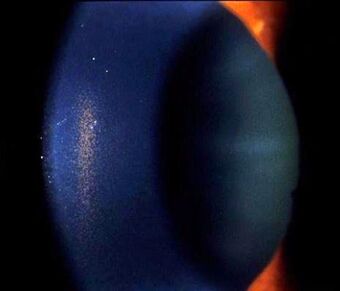Medicine:Krukenberg's spindle
From HandWiki
| Krukenberg's spindle | |
|---|---|
 | |
| Slit lamp photograph showing Krukenberg's Spindle as pigment cell deposits on the cornea | |
| Specialty | Ophthalmology |
Krukenberg's spindle is the name given to the pattern formed on the inner surface of the cornea by pigmented iris cells that are shed during the mechanical rubbing of posterior pigment layer of the iris with the zonules that are deposited as a result of the currents of the aqueous humor. The sign was described in 1899 by Friedrich Ernst Krukenberg (1871-1946), who was a German pathologist specialising in ophthalmology.[1]
Diagnosis
Differential diagnosis
Iritis
- Painful red eye with photophobia associated with inflammation
Vortex keratopathy
- Corneal deposits also known as cornea verticillata, caused by netarsudil eye drops or chronic amiodarone use for cardiac arrhythmias.[2]
Corneal guttata
- Non-transparent collagen deposits appearing following loss of corneal endothelial cells[3]
See also
References
- ↑ Krukenberg F. (1899) Beiderseitige angeborene Melanose der Hornhaut. Klin Mbl Augenheilkd 37:254-258.
- ↑ Chew, E; Ghosh, M; McCulloch, C (June 1982). "Amiodarone-induced cornea verticillata.". Canadian Journal of Ophthalmology 17 (3): 96–9. PMID 7116220.
- ↑ "Corneal guttata associated with the corneal dystrophy resulting from a betaig-h3 R124H mutation". The British Journal of Ophthalmology 84 (1): 67–71. January 2000. doi:10.1136/bjo.84.1.67. PMID 10611102.
External links
 |

